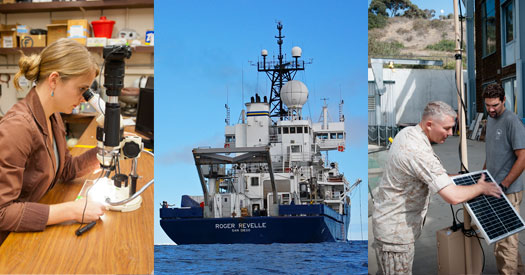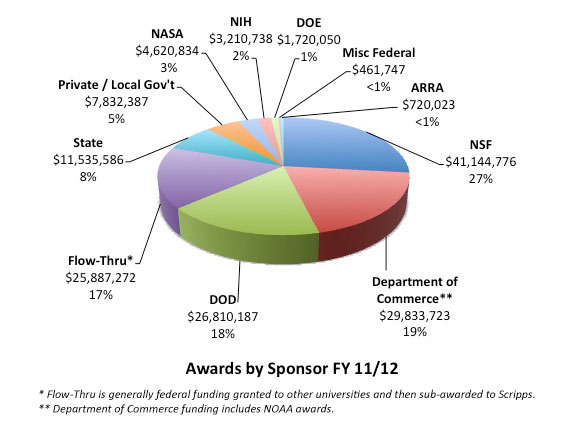
Scripps Oceanography Reaches $150 Million Research Milestone
Sponsored projects awards at leading ocean and earth science institution achieve record due to successful competition for research funds
By:
- Cindy Clark
Published Date
By:
- Cindy Clark
Share This:
Article Content
Scripps continues to serve as economic engine for the local region and provides valuable return on investment
This year, for the first time, external funding for sponsored research by scientists at Scripps Institution of Oceanography at UC San Diego exceeds $150 million (excluding ARRA* funding). Such funding arises from innovations and ideas of Scripps scientists and researchers who perform initial exploration of the concepts and compete in rigorous external competitive processes for funding.
- American Recovery and Reinvestment Act
The funded research covers a vast array of ocean, atmosphere, and earth science investigations.
Over the last six years, Scripps’ total operating funds exceed $1 billion. Over that six-year period, roughly 15% came from the University of California and 85% from other sources, including federal and state agencies, industry, and private sources. Over this same time frame, funding for sponsored research has grown from about $106 million to $153 million.

(from left) Scripps graduate student researcher Christina Frieder; research vessel Roger Revelle; and Scripps engineer Joel Hazard (right) with an XMET unit, a meteorological instrument package that has aided combat operations.
As of June 30, private support to Scripps Oceanography for critical areas such as student support, research, equipment, and capital improvements to the Scripps community reached a total of $11.33 million, a 63% increase over last fiscal year. These contributions came from individuals, foundations, and corporations.
“During these difficult economic times, we are grateful that federal, state and private entities continue to support our excellent research and education programs and to trust our careful stewardship of taxpayer and donor funds,” said Scripps Director and UC San Diego Vice Chancellor Tony Haymet. “Along with world-class research and observation programs, we are also training the next generation of students and scientists, and delivering needed environmental information to California citizens.”
“On behalf of the people of San Diego, I want to congratulate Scripps on all their success here over the past 109 years,” said San Diego Mayor Jerry Sanders. “We are very grateful for all they have done for San Diego and proud of what they have accomplished. Given their recent performance, it looks like they’ll be continuing their good work here for many years to come.”
“Science is the engine that moves technology, industry, and society. It is also the spoke of the wheel that is K through 12, university, and post-graduate education,” said Tom Torlakson, California State Superintendent of Public Instruction. “As a former high school science teacher, I appreciate every day the value of this cycle of excellence in California, and especially the signal role that Scripps Institution of Oceanography at UC San Diego plays in it. I congratulate Scripps on record success at every level during the most challenging of times for science and the economy.”
Scripps works across the earth, ocean, and atmosphere. Scripps scientists lead the way in environmental research, marine genomics, and deep-sea exploration, translating these innovations and discoveries into useful information and new technologies. One way Scripps accomplishes that is through collaborations with mission agencies such as the U.S. Navy.
Scripps Science Benefits National Security and Military Objectives
More than $31.87 million in total funding comes from the Department of Defense (DOD), reflective both of Scripps’ long history of collaboration with its many branches and of Scripps’ singular capacity to assist military operations as the Pacific Rim becomes a new primary DOD focus area, and in particular U.S. Navy-funded ship operations and new technology development.
DURIP Supports Next-generation Instrument Development at Scripps
Defense University Research Instrumentation Program (DURIP) grants recently announced for award to Scripps researchers will expand the capabilities of autonomous underwater vehicles, which have become increasingly valuable tools for science and military objectives in recent years.
As the Navy relies more upon unmanned underwater technologies to support its missions, it is important that organizations such as Scripps have access to these technologies to efficiently develop new sensors, operating strategies, and data synthesis tools to support forecast models, said oceanographer Eric Terrill, who will be awarded funds to acquire an underwater platform and specialized sensors.
Including Terrill, four Scripps Oceanography researchers were named as Navy DURIP recipients to acquire and deploy instruments in support of studies ranging from coastal oceanography to deep-ocean acoustics. The awards mark the continuation of a collaboration between Scripps and the Navy that predates World War II.
The DOD will provide nearly $5.3 million to Scripps for six research projects to improve current capabilities, or develop new capabilities, to perform cutting-edge national security research.
These funds complement some $23.3 million that the Navy awarded Scripps for research and ship operations in 2011. A portion of the funding supports the purchase of instruments and components from manufacturers in several states that work with Scripps. Scripps leads the country in the amount of DURIP award funds it has received, further illustrating Scripps' competitive talent for attracting external funding.
More at:
In total last year, Scripps performed nearly $30 million worth of research for the Navy. Much of the work was directly supported by the DOD to meet future naval needs. Forecasts and assessments of the ocean and coastal environments will continue to allow the Navy to remain responsive to emerging missions, while operating in the current economic downturn.
Scripps Research Fleet Adds to Local and National Economy
Scripps’ world-leading academic research fleet focuses more than one-fourth of its total ship time on Office of Naval Research-supported fieldwork, a recognition of the evolving mission of U.S. Armed Forces.
Research funding awarded to Scripps scientists provides direct and indirect economic benefits to the region and the nation. In some cases, research grants pay salaries for Scripps private-sector collaborators. Funding of research instrumentation awarded to Scripps will enable the institution to place orders for technology manufactured by firms throughout the United States.
The Scripps research fleet also supports a range of local and regional contractor services ranging from marine electronics to purchases from the local dairy. Examples in the past fiscal year include more than $230,000 spent in a Chula Vista shipyard for dry dock services and more than $17,000 spent on local paint services.
Practical examples of Scripps research projects that benefit the local, regional, and national communities include:
Navy Selects Scripps to Operate New Research Vessel
The U.S. Navy is providing funding for a new 238-foot oceanographic research vessel to be operated by Scripps with a planned launch in 2015. AGOR 28 will advance Scripps' pursuits of the planet's most vital environmental and scientific challenges, while supporting research objectives for the Office of Naval Research, including national security. The arrival of AGOR 28 is projected to carry $10 million in annual economic impact. Scripps currently spends more than $25 million per year to support its San Diego-based fleet of research vessels.
More at:
- Navy Selects Shipyard to Build Scripps' New State-of-the-art Research Vessel
- Around the Pier: Government Funding Supports New Scripps Ship and Vital Sea Going Research
State and Nation Benefit from Scripps' Climate Research
Scripps Institution of Oceanography is also the largest recipient of funding from NOAA for sustained observing and environmental research. Such investment made in Scripps research is exceeded by the value of the knowledge that research has produced. For instance, funding from federal and state science and public health agencies in the past fiscal year helped researchers identify a trend toward more frequent and more intense nighttime heatwaves – a finding that can guide estimates of future demand for energy, trauma care, and other public services. Other climate research vital to science and society includes ongoing research into the dynamics of the Sierra Nevada snowpack and the state’s water supply.
Scripps Helps Pioneer a Historic Dive to the Deep
For decades, Scripps scientists and engineers have pioneered exploration of the deepest parts of the world’s oceans. The deep sea is Earth’s least explored environment and features the planet’s largest ecosystem. In a recent record-setting dive, Scripps scientist Doug Bartlett served as chief scientist and engineer Kevin Hardy contributed to James Cameron’s historic DEEPSEA CHALLENGE to the Mariana Trench, the first solo dive there in history.
More at:
New Research Building Contributes to Science Excellence and Local Economy
A $12 million federal grant awarded to Scripps Oceanography in 2008 by the Department of Commerce National Institute of Standards and Technology has helped fund construction of a new research building at Scripps to house the Marine Ecosystem Sensing, Observation and Modeling (MESOM) Laboratory. MESOM will enable much needed sensor/instrument development and space for coastal ecosystem biologists to work collaboratively to further an integrated approach to understanding California's coastal waters. The research will provide the foundation for a new approach to management of the State of California's marine ecosystems and resources.
Scripps, a leader in research to understand impacts on marine ecosystems, has hundreds of research programs under way aimed at gaining comprehensive understanding of the oceans, atmosphere, and structure of the planet.
More at:
- Scripps Oceanography Awarded New Research Building to Study Fragile Marine Ecosystems
- U.S. Commerce Secretary Gary Locke Breaks Ground on Major San Diego-Area Recovery Act Project
Scripps Start-ups Boost Local Economy
In 2010 Scripps Oceanography spun off two private companies, EarthRisk Technologies, a maker of climate forecast products based near downtown San Diego, and MRV Systems, a Sorrento Valley-based company making ocean robots for the Navy and academic research centers around the country. EarthRisk employs 14 full- and part-time staffers and indirectly supports five other positions at partnering organizations. MRV Systems employs six full-time employees.
More at:
Employment Impact in the San Diego Region
With this year's milestone in sponsored projects awards, Scripps remains an integral part of the education and research excellence of UC San Diego. Nearly 1,000 non-UC San Diego workers have been employed over the past fiscal year on construction, renovation, upgrade, and maintenance of facilities that support the research enterprise at Scripps Institution of Oceanography.
Annual Reports of Scripps Institution of Oceanography
- 2011-2012 (coming soon)
- 2010-2011 (PDF)
- 2009-2010
- 2008-2009
- 2007-2008
- 2006-2007
Share This:
Stay in the Know
Keep up with all the latest from UC San Diego. Subscribe to the newsletter today.



